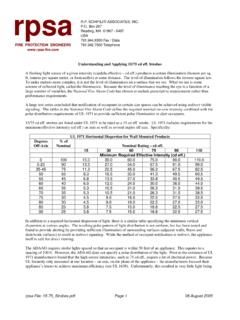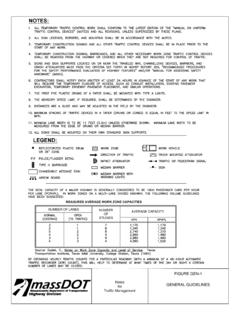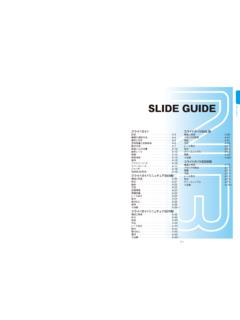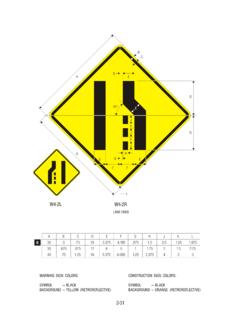Transcription of Sample Fire Alarm System Calculations
1 Rpsa fire PROTECTION ENGINEERS. SCHIFILITI ASSOCIATES, INC. Box 297. Reading, Massachusetts 01867 - 0497. USA. Fax / Data Telephone Sample fire Alarm System Calculations 1. A fire Alarm manufacturer specifies a maximum allowable loop resistance of 50 1. What is the maximum allowable distance from the control unit to the last device if a #16 AWG. stranded, un-coated copper wire is used? Assume a temperature of 750C. How does this change if the temperature is 200C? Rmax = 50 1 = 2 RW 1 R. W. R W = Ru D 1 R. W. Rmax = 50 1 = 2 Ru D 1. Ru = 1/1000 ft or 1 per handout table for D=L/2. #16 AWG stranded, uncoated copper wire at 750C. Rmax 50. D= = = 5010 = 5000 ft 2 Ru 2( ).
2 Part B If T = 200C calculate the unit resistance, Ru, at the lower temperature (it should be less since resistance is lower at lower temperatures leading to super cooled super conductors): R2 = R1 [1 + 9 (T 2 - 75)] where: 9Cu = R2 = [1 + (20 - 75)] 1/ft or R2 = [1 + (20 - 75)] 1/1000 ft R2 = 1/ft Rmax 50. D= = = 6092 = 6000 ft 2 Ru 2( ). 2. If a #24 AWG conductor has a resistance of 1/1000 ft at 200C what is the maximum allowable distance from the control unit to the last device for a System having a maximum allowable loop resistance of 501. 1? Rmax 50. D= = = 974 = 1000 ft 2 Ru 2( ). rpsa File: Sample fire Alarm System Page 1 05 October 2000. 3. Plot total loop resistance, RT, as a function of circuit distance (D = L/2) for 14, 16, 18, 22.
3 And 24 AWG uncoated solid copper wire. Use unit resistances of , , , , and 1/1000 ft respectfully. R W = Ru D 1 R. W. R T = 2 RW = 2 R u D 1. R. W. r Plotting RT as a function of D will result in a straight line having a slope of 2Ru and a Y intercept of 0. D=L/2. Also, a test of the data or the plot is: When L = 1000 ft, RT = 1000 Ru 1. This occurs at D = L/2 = 500 ft So, at D = 500 ft we should see RT = 1000 Ru 1. D, ft #14 AWG #16 AWG #18 AWG #22 AWG #24 AWG. See plots on next page. rpsa File: Sample fire Alarm System Page 2 05 October 2000. rpsa fire PROTECTION ENGINEERS. Loop Resistance (Loop is 2 x D). (Solid, uncoated copper at 750C). RT = 2 RW RW = RU D RT = 2 RU D.
4 R. W. R. Total Loop Resistance, RT, Ohms W. #14 AWG. #16 AWG. #18 AWG. #22 AWG. #24 AWG. Distance, D, from Panel to Last Device, ft Loop Resistance (Loop is 2 x D). (Solid, uncoated copper at 750C). Total Loop Resistance, RT, Ohms #14 AWG. #16 AWG. #18 AWG. #22 AWG. #24 AWG. rpsa Distance, D, from Panel to Last Device, ft rpsa File: Sample fire Alarm System Page 3 05 October 2000 fire PROTECTION ENGINEERS. 4. A notification appliance circuit (NAC) serves four horns located in a remote portion of a building. The circuit is approximately 400 feet from the panel to the last appliance and is wired using #16 AWG stranded, uncoated copper wire. Each appliance is rated to draw amps at a nominal 24 volts DC.
5 The appliances are rated to produce 78 dBA at 3. meters as long as the voltage is no less than 22 nor more than 29 VDC. The fire Alarm power supply is rated at a nominal 24 VDC. Calculate the voltage across the horns and determine if it is sufficient to operate the horns at the rated sound pressure level (SPL). Simplified calculation methods are permitted. Is a larger (smaller AWG number) wire size needed? If so, what size? Can a smaller (larger AWG number) wire size be used? The diagrams below show how the circuit analysis can be simplified. E. O. L. Ignore EOL. IT iw 2 iw 3 iw 4. rw 1 rw 2 rw 3 rw 4. ih 3. rh1 rh2 rh3 rh4. ih 1. ih 2. ih 4. DC. rw 8 rw 7 rw 6 rw 5.
6 IT iw 7 iw 6 iw 5. DC. IT. RW. VDC VH. IT. DC RH. RW. IT. rpsa File: Sample fire Alarm System Page 4 05 October 2000. rpsa fire PROTECTION ENGINEERS. There are two methods to solve for the voltage across the horns (load) using the simplified circuit diagram. The first assumes that the load will not draw the nominal rated current because they will be operating at a reduced voltage, not their nominal rated voltage. The second method assumes that the current draw by the load will be the nominal even though the reduced voltage will actually result in a smaller current draw. In addition to the two possible calculation methods, we must choose a starting voltage.
7 Although the nominal voltage of the power supply is 24 VDC, it is reasonable to assume that if it switches to batteries as a secondary power supply, the voltage will decrease or degrade over the required supply time. NFPA 72 and UL require a power supply even secondary power to put out no less than 85% of the nominal voltage. Therefore: VDC = x 24 = VDC as a starting voltage SOLUTION # 1. The resistance of each horn is calculated using the nominal voltage and current specified by the manufacturer: rh = v/i = 24 = 480 1. The equivalent resistance of 4 horns in parallel is: 1 1 1 1 1 4. = + + + =. RH rh1 rh 2 rh 3 rh 4 480. RH = 120 . The resistance of each length of wire is.
8 RW = Ru D = 400 ft = . 1000 ft . The total resistance of the circuit, RT, is the sum of all three series resistances: RT = RW + RW + RH = + + 120 = 1. When a voltage of VDC is applied across a resistance of 1, how much current flows? VDC IT = = = Amps or 165 mA. RT rpsa File: Sample fire Alarm System Page 5 05 October 2000. rpsa fire PROTECTION ENGINEERS. The voltage at the load is then: VH = IT RH = (120) = = 20 VDC. In this problem we were told that The appliances are rated to produce 78 dBA at 3 meters as long as the voltage is no less than 22 nor more than 29 VDC . Therefore, we must be sure that the appliances receive at least 22 VDC. Since 20 < 22 they will not sound at full volume.
9 However, is 22 VDC really the lowest voltage at which they will operate correctly? At the present time, if a manufacturer's specifications list such a range requires that the horn actually work at 80% of that low number: x 22 = Therefore, the answer depends on which voltage is really the lowest the horns require to sound at full volume. If we assume that they really will work at a minimum voltage of , then the wire size is adequate. So, if I were analyzing a set of conditions such as these, I would conclude they would work. However, for a design or design review we would set a goal with a factor of safety. I think it would be reasonable to use 10 to 20% factor of safety.
10 I would prefer that a proposed circuit not drop below the manufacturer's specified minimum. But if we start with a degraded power supply at VDC we are already below the manufacturer's stated minimum of 22 VDC. A 10% factor of safety would require that the voltage not drop below x 22 = = 20 VDC. The circuit in this situation would just meet that criteria. SOLUTION # 2. Assume the actual current flow is equal to the nominal current flow: IT = ih1 + ih2 + ih3 + ih4 = 4(ih) = 4( ) = A. VDC VW VH VW = 0. VH = VDC 2 VW. VH = 2 IT RW.. RW = Ru D = 400 ft = . 1000 ft . VH = 2 ( ) ( ) = = 20 VDC. rpsa File: Sample fire Alarm System Page 6 05 October 2000. rpsa fire PROTECTION ENGINEERS.




